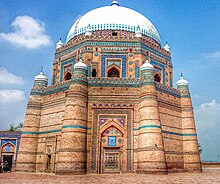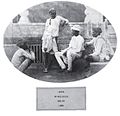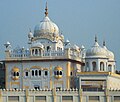Portal:Punjab: Difference between revisions
Added a new topics section: {{Box-header colour|Some topics|noedit=yes}} {{Plain navboxes|content={{Ethnic and social groups of the Punjab|state=expanded}}}} {{Plain navboxes|content={{Punjab, India|state=expanded}}}} {{Plain navboxes|content={{Punjab, Pakistan|state=expanded}}}} {{Box-footer}} |
Expand portal by adding prominent geographic articles to the SA section |
||
| Line 23: | Line 23: | ||
|8=Punjab, India |
|8=Punjab, India |
||
|9=Punjab, Pakistan |
|9=Punjab, Pakistan |
||
|10= |
|10=Faisalabad |
||
|11= |
|11=Rawalpindi |
||
|12= |
|12=Gujranwala |
||
|13= |
|13=Multan |
||
|14= |
|14=Ludhiana |
||
|15= |
|15=Amritsar |
||
|16= |
|16=Chandigarh |
||
|17= |
|17=Jalandhar |
||
|18= |
|18= |
||
|19= |
|19= |
||
Revision as of 03:40, 20 June 2020
|
The Punjab Portal Introduction Punjab (/pʌnˈdʒɑːb, -ˈdʒæb, ˈpʊn-/; Punjabi: [pə̞ɲˈdʒäːb] ; also romanised as Panjāb or Panj-Āb), also known as the Land of the Five Rivers, is a geopolitical, cultural, and historical region in South Asia. It is specifically located in the northwestern part of the Indian subcontinent, comprising areas of modern-day eastern-Pakistan and northwestern-India. Punjab's major cities are Lahore, Faisalabad, Rawalpindi, Gujranwala, Multan, Ludhiana, Amritsar, Sialkot, Chandigarh, Shimla, Jalandhar, Patiala, Gurugram, and Bahawalpur. Punjab grew out of the settlements along the five rivers, which served as an important route to the Near East as early as the ancient Indus Valley civilization, dating back to 3000 BCE, followed by migrations of the Indo-Aryan peoples. Agriculture has been the chief economic feature of the Punjab and formed the foundation of Punjabi culture. The Punjab emerged as an important agricultural region, especially following the Green Revolution during the mid-1960s to the mid-1970s, and has been described as the "breadbasket of both India and Pakistan." Punjab's history is a tapestry of conflict, marked by the rise of indigenous dynasties and empires. Following Alexander the Great's invasion in the 4th century BCE, Chandragupta Maurya allied with Punjabi republics to establish the Maurya Empire. Successive reigns of the Indo-Greek Kingdom, Kushan Empire, and Indo-Scythians followed, but were ultimately defeated by Eastern Punjab Janapadas such as the Yaudheya, Trigarta Kingdom, Audumbaras, Arjunayanas, and Kuninda Kingdom. In the 5th and 6th centuries CE, Punjab faced devastating Hunnic invasions, yet the Vardhana dynasty emerged triumphant, ruling over Northern India. The 8th century CE witnessed the Hindu Shahis rise, known for defeating the Saffarid dynasty and the Samanid Empire. Concurrently, the Tomara dynasty and Katoch Dynasty controlled eastern Punjab, resisting Ghaznavid invasions. Islam took hold in Western Punjab under Ghaznavid rule. The Delhi Sultanate then succeeded the Ghaznavids in which the Tughlaq dynasty and Sayyid dynasty Sultans are described as Punjabi origin. The 15th century saw the emergence of the Langah Sultanate in south Punjab, acclaimed for its victory over the Lodi dynasty. After the Mughal Empire's decline in the 18th century, Punjab experienced a period of anarchy. In 1799 CE, the Sikh Empire established its rule, undertaking conquests into Kashmir and Durrani Empire held territories, shaping the diverse and complex history of Punjab. The boundaries of the region are ill-defined and focus on historical accounts and thus the geographical definition of the term "Punjab" has changed over time. In the 16th century Mughal Empire the Punjab region was divided into three, with the Lahore Subah in the west, the Delhi Subah in the east and the Multan Subah in the south. Under the British Raj until the Partition of India in 1947, the Punjab Province encompassed the present Indian states and union territories of Punjab, Haryana, Himachal Pradesh, Chandigarh, and Delhi, and the Pakistani regions of Punjab, and Islamabad Capital Territory. The predominant ethnolinguistic group of the Punjab region are the Punjabi people, who speak the Indo-Aryan Punjabi language. Punjabi Muslims are the majority in West Punjab (Pakistan), while Punjabi Sikhs are the majority in East Punjab (India). Other religious groups include Hinduism, Christianity, Jainism, Zoroastrianism, Buddhism, and Ravidassia. (Full article...) Selected article - Multan (مُلتان; [mʊltaːn] ) is a city in Punjab, Pakistan, located on the bank of river Chenab. It is one of the five largest urban centres of Pakistan in 2024 and serves as the administrative centre of Multan Division. A major cultural, religious and economic centre of Punjab region, Multan is one of the oldest inhabited cities of Asia, with a history stretching deep into antiquity. Multan became part of the Achaemenid Empire in the early 6th century BC. The ancient city was site of the renowned Multan Sun Temple, and was besieged by Alexander the Great during the Mallian Campaign. Later it was conquered by the Umayyad military commander Muhammad bin Qasim in 712 CE after the conquest of Sindh. In 9th century it became capital of the Emirate of Multan. The region came under the rule of the Ghaznavids and the Delhi Sultanate in the medieval period. In 1445, it became capital of the Langah Sultanate. After administrative reforms of Mughal emperor Akbar, it became one of the provinces of the Mughal Empire. In 1848, it was conquered by the British from Sikh Empire and became part of British Punjab. (Full article...)Selected biography
Manmohan Singh (born 26 September 1932) is an Indian economist and politician who served as the Prime Minister of India from 2004 to 2014. The first Sikh in office, Singh was also the first prime minister since Jawaharlal Nehru to be re-elected after completing a full five-year term.
Born in Gah (now in Punjab, Pakistan), Singh's family migrated to east Punjab during its partition in 1947. After obtaining his doctorate in economics from Oxford, Singh worked for the United Nations during 1966–69. Following the advice of International Monetary Fund in 1991, Singh as Finance Minister, freed India from the Licence Raj, source of slow economic growth and corruption in the Indian economy for decades. He liberalised the Indian economy, allowing it to speed up development dramatically. During his term as Prime Minister, Singh continued to encourage growth in the Indian market, enjoying widespread success in these matters. Singh, along with the former Finance Minister, P. Chidambaram, have presided over a period where the Indian economy has grown with an 8–9% economic growth rate. Some topicsCategoriesSelect [►] to view subcategories
Select [►] to view subcategories
1799-1849 definition: Chandigarh - Delhi - Eastern Punjab state - Federally Administered Tribal Areas - Galgit - Haryana - Himachal Pradesh - Islamabad Capital Territory - Jammu - Kashmir - Khyber Pass - Khyber Pakhtunkhwa - Ladakh - Western Punjab province 1947 definition: Chandigarh - Delhi - Eastern Punjab state - Haryana - Himachal Pradesh - Islamabad Capital Territory - Western Punjab province Present definition: Chandigarh - Eastern Punjab state - Western Punjab province Major cities: Amritsar - Bathinda - Chandigarh - Faisalabad - Lahore - Ludhiana - Multan - Patiala - Sialkot Related portalsPunjabi WikiprojectsWikiProject Punjab was formed to foster better articles on the region of Punjab with a spirit of cooperation. The project is a home base that provides a place for Wikipedians (editors) to discuss issues, while share information and resources regarding improvements to Punjabi related articles, which can be discussed at the project's talk page. To join WikiProject Punjab (anyone may join), simply list your username on the members page. Editors are also encouraged to participate in the more regional and/or topic specific WikiProject 's as listed below.
Things you can doAssociated WikimediaThe following Wikimedia Foundation sister projects provide more on this subject:
Wikipedia in Punjabi
Discover Wikipedia using portals |


























































